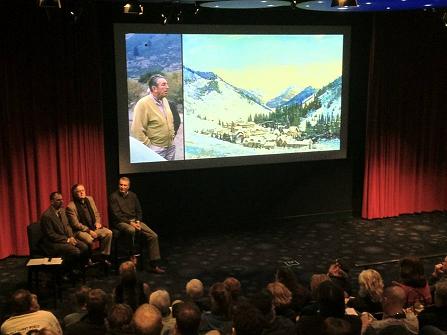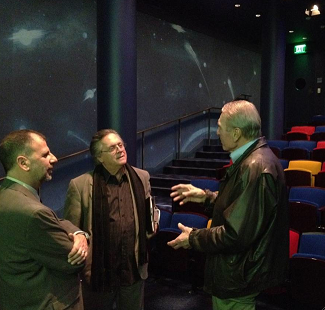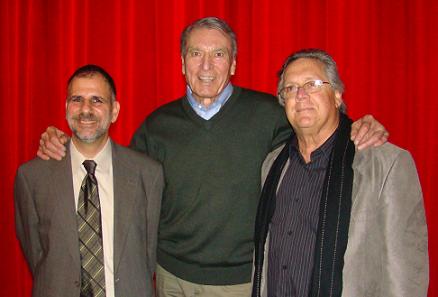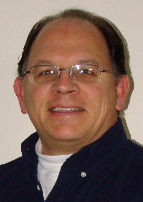While he did not live to see it completed, many Disney fans know that, at the time of his passing in 1966, Walt Disney was working on plans for what would later become Walt Disney World in Florida. What is not so well known is that he was concurrently planning a year round family resort in the Sierras known as Mineral King.
 This past Saturday, in the Walt Disney Family Museum Theater, Sam Gennawey, author of Walt and the Promise of Progress City moderated a fast paced and highly informative presentation on the origins and plans for Walt Disney’s family oriented ski resort that, sadly, was never completed. He was joined by Ron Miller, past President and CEO of Walt Disney Productions and co-founder of the Walt Disney Family Museum and architect David Price, President of Leisure Group and son of Disney Legend Harrison “Buzz” Price.
This past Saturday, in the Walt Disney Family Museum Theater, Sam Gennawey, author of Walt and the Promise of Progress City moderated a fast paced and highly informative presentation on the origins and plans for Walt Disney’s family oriented ski resort that, sadly, was never completed. He was joined by Ron Miller, past President and CEO of Walt Disney Productions and co-founder of the Walt Disney Family Museum and architect David Price, President of Leisure Group and son of Disney Legend Harrison “Buzz” Price.
Gennawey began by noting that Walt Disney, through the excellence of his product, had established the expectations we have today in the worlds of animation and amusement parks. Through his planned Mineral King project, he was about to establish a new set of expectations of how we would think about ski resorts and family vacation destinations. Gennawey went on to explain an underlying operating principle that Walt and his staff frequently employed when planning any new project…the“Yes if…” principle. The idea was that opportunities could be successfully realized if the team continuously asked themselves “Yes, this can happen if we first do this…” It was a positive method of goal orientation for anticipating and resolving issues before they impeded progress toward a goal. This is in contrast to how many individuals and organizations operate, which is the “No, because…” approach. This method can overwhelm a team by focusing on the roadblocks which obscure the intended goal and can lead to a loss of momentum. Walt and his team employed the “Yes if…” principle to the project that became known as Mineral King.
Walt Disney’s interest in winter sports, and skiing in particular, dates back to the 1930s when, on a skiing trip to Badger Pass, he be-friended Hannes Schroll. Schroll was a former Austrian skiing champion who ran the Yosemite Ski School. Scholl and others purchased land near Donner Summit, helped in part by a $2,500.00 investment by Walt Disney. The land was developed into the Sugar Bowl resort we know today. To acknowledge Walt’s investment and friendship, an 8,000 ft. peak at the resort was named Mt. Disney. Sugar Bowl went on to boast the first chairlift in California. It was known as the “Disney Chair”.
Interestingly, Hannes Scholl, a prolific yodeler, provided the famous Goofy Yell (aahh…ho…ho…hooey!) for the first of the Goofy “How to…” shorts, The Art of Skiing. The fact that skiing was subject matter of the first cartoon in this popular series is a likely indication of Walt’s enthusiasm for the sport and the Sugar Bowl resort. In fact, the short opens with a zoom in shot of the Sugar Bowl Lodge.
Walt’s exposure to, and involvement with, winter destinations continued in the mid 1950’s during the production of the live action film Third Man On The Mountain in the Swiss Alps. Here Walt saw firsthand the majestic Matterhorn towering high above the charming village of Zermatt. The only way into the village, where motor vehicles are prohibited, is by cog train. The lack of roadway into the mountain location was a precursor to a major issue Disney would confront nearly a decade later on his Mineral King project. The director of the movie, Ken Annakin, commented that as a result of visiting the Alps, “Walt loved all things Switzerland”.
 Inspired by the Matterhorn and wanting to expand the attractions in his new Disneyland theme park; Walt asked his Imagineers to create an attraction that would bring the excitement of a bobsled run into the park. Taking the concept of a rollercoaster to a totally new level, Walt and his team envisioned making this “new” thrill ride an actual trip down a mountainside. Of course, the mountain, upon whose slopes we would travel, would be the Matterhorn. Always the innovator, in addition to creating the first truly themed rollercoaster, Walt Disney and his Matterhorn gained the distinction of being the first tubular steel track coaster. It is the construction method used by most new rollercoasters to this day. When it opened in 1959, at 147 ft. tall, the Matterhorn was the tallest structure in Orange County.
Inspired by the Matterhorn and wanting to expand the attractions in his new Disneyland theme park; Walt asked his Imagineers to create an attraction that would bring the excitement of a bobsled run into the park. Taking the concept of a rollercoaster to a totally new level, Walt and his team envisioned making this “new” thrill ride an actual trip down a mountainside. Of course, the mountain, upon whose slopes we would travel, would be the Matterhorn. Always the innovator, in addition to creating the first truly themed rollercoaster, Walt Disney and his Matterhorn gained the distinction of being the first tubular steel track coaster. It is the construction method used by most new rollercoasters to this day. When it opened in 1959, at 147 ft. tall, the Matterhorn was the tallest structure in Orange County.
In the late 1950s, Walt was approached by Prentice Hale, of the retail chain Carter Hawley Hale, to be the Chairman of Pageantry for the California Organizing Olympic Committee for the 1960 Winter Olympic Games to be held in near Lake Tahoe. Walt would be responsible for creating new and visually pleasing Opening and Closing Ceremonies for the first ever televised Winter Games. Walt agreed and he and his staff created a new standard for all Olympic Games ceremonies that followed. His ceremonies included marching bands and choirs. Doves were released, there were fireworks as well as flags dropped by parachute and, of course balloons. These Disney inspired ceremonies provided the common elements that we take for granted to this day in televised sports ceremonies, including the Super Bowl halftime show.
Willie Schaelffler, a German American skiing champion had laid out the runs in the area or the 1960 Winter Olympic Games. Walt watched Willie and his staff groom the ski runs and became inspired to look into perhaps creating a ski resort of his own. Walt asked Willie to help with the search for a location. He also engaged longtime advisor, Buzz Price, who had recommended the site for Disneyland in the 1950s; to begin the search for possible locations that could be developed into a ski resort. Sites that were considered included: San Gorgonio, Aspen, Mammoth and ultimately Mineral King.
Mineral King was selected for several reasons. It was roughly half way between Los Angeles (228 mi.) and San Francisco (271 mi.). It included 15,000 acres of land with mountain peaks at 12,400 ft. There was a valley at 7,200 ft. which was 2 miles in length and ¼ mile wide. The high peaks surrounding this valley protected it from wind, making topography and conditions ideal for skiers. Willie Schaelffler, a world class skier, commented: “Mineral King has the largest, finest skiing areas grouped in a compact region that I have ever seen. Nothing in America, Europe, or anywhere else in the world compare with it.” In addition to being a highly function location, the Mineral King site was exceptionally beautiful as well. In 1903, William Dudley wrote in the Sierra Club Bulletin: “There is nothing in the whole Sierra range more beautiful than the valley of Mineral King in June; nothing more like an upper valley in the Swiss Alps”.
Steps were put in place to acquire a lease for the Mineral King property area which was controlled by the US Department of Agriculture. Access would be an issue since Mineral King was surrounded on three sides by Sequoia National Park which was under the jurisdiction of the US Department of the Interior. It was a complex set of circumstances, but they were overcome on December 17, 1965 when Walt Disney Productions was awarded a preliminary permit giving the company three years to complete a satisfactory plan, which, if accepted would pave the way for a 30 year permit for development of the property.
Ron Miller recounted a helicopter ski trip to the summit of the Mineral King range. He said there were terrific bowls for skiing and at the time there was 18ft of snow on the summit. He was reminded by Diane Disney Miller, as the audience enjoyed family photos of the trip; that he fell down a lot making his ski run down the mountain. In a light moment of good natured family ribbing, Ron (a former NFL player) lovingly reminded Diane that the conditions were crusty and he had a tendency to sink into the crust while she had simply skied in Willie Schaelffler’s tracks to avoid a fall herself.
David Price shared his recollections of the beauty of valley in the summertime. In addition, he shared several of his sketches showing the mountains and cabins he experienced as a teenager visiting Mineral King with the Price family. He also provided an insight into his father’s relationship with Walt Disney that may have had financial implications that David still has some minor regrets about. As a trusted consultant and advisor to Walt Disney, Buzz Price felt that it was important to maintain a totally independent and objective relationship with Walt. To that end, Buzz never purchased Disney stock. When he had the opportunity to buy a parcel of land adjacent to the Disneyland property, he declined. David Price admitted to having thoughts of “what might have been” each time he drives by that parcel of land today.
With the permit in place, development plans proceeded for a family oriented year round resort that would provide excellent skiing and accommodations in the wintertime and equally exciting activities in the summer months. The Country Bear Jamboree was initially conceived as an attraction for Mineral King. The goal was to develop a world class resort that minimized the infrastructure footprint and maximized the preservation of the natural beauty of the location. Guest rooms would be in low rise buildings, to allow for maximum unspoiled views of the mountains. All but one ski run would be hidden behind the trees so as to not spoil the experience of being in a natural wilderness setting.
Momentum was building and culminated in a press conference at Mineral King on September 19, 1966 to announce the plans for the upcoming resort. Governor Edmund G. Brown was on hand to lend support for the project and to announce that funding for a year round accessible roadway was in the works. All appeared to be in order when, on December 15, 1966, Walt Disney passed away.
 After Walt’s passing, several events led to the demise of the Mineral King Project. The Sierra Club brought suit contesting the scope of the project and its impact on the natural surroundings. As the litigation continued, rising costs required reduction in the size of the planned resort. Alternatives to the roadway were explored, one of which included building a cog railway (as near Zermatt, Switzerland) to eliminate the need for cars to access the resort. But, momentum was waning. The continued legal challenges, reductions in funding and the lack of Walt Disney’s inspiring and influential presence; ultimately resulted in the project being dropped.
After Walt’s passing, several events led to the demise of the Mineral King Project. The Sierra Club brought suit contesting the scope of the project and its impact on the natural surroundings. As the litigation continued, rising costs required reduction in the size of the planned resort. Alternatives to the roadway were explored, one of which included building a cog railway (as near Zermatt, Switzerland) to eliminate the need for cars to access the resort. But, momentum was waning. The continued legal challenges, reductions in funding and the lack of Walt Disney’s inspiring and influential presence; ultimately resulted in the project being dropped.
The project, whose stated goal was to preserve the natural beauty of Mineral King, was challenged by environmental groups as a potential detriment to the land. Ironically, Walt Disney was awarded The American Forestry Association Award for “outstanding service in the conservation of American Resources”. Even though the Mineral King ski resort never became a reality, Walt also received the Hans Georg Award for elevating the sport of skiing.
Gennawey summarized by pointing out that Walt Disney was constantly trying to build community through three dimensional design. We see the evidence back to the excellent state of the art design used at the new studio in Burbank in 1940. We see it in his Holmby Hills miniature railroad that inspired his next project, Disneyland.
At the time of his passing, Walt was envisioning even better community design for EPCOT and Mineral King and beyond. He wanted to show the world that a clean, efficient and enjoyable urban and suburban environment was within our grasp. He also wanted to continue to explore the possibilities for family oriented vacations and entertainment. While Walt Disney World’s EPCOT did not totally evolve as Walt had envisioned and Mineral King was never completed; we can still see Walt’s vision in the Disney Cruise Line and the new Aulani resort in Hawaii. Thanks for the vision and inspiration Walt!

Frank Teurlay
Volunteer at The Walt Disney Family Museum
